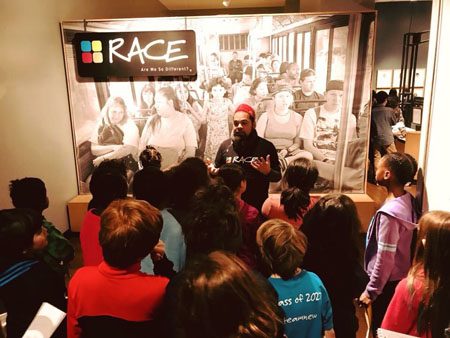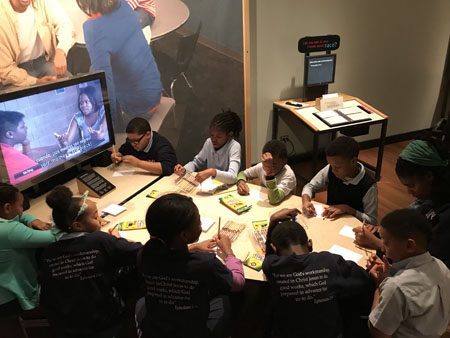Hector Gonzalez is the gallery engagement lead for Race: Are We So Different? from November 2017 until July 2018. In this blog post, he reflects on his experience thus far.
My time in the Race: Are We So Different? exhibition brings up mixed emotions. Yes, it is a very powerful experience and has confirmed that we still have a very long way to go as a society in terms of race relations and need to continue to have in-depth conversations on race, especially with the current political climate. The creation of race as we know it has done more harm than good and its integration into the fabric of society unfortunately continues to be refashioned in many ways that are reminiscent of the eugenics movement and/or remixed into new forms of divisive race-based hate, i.e. institutional racism, microaggressions, and the alt-right.

Hector meets a school group at the entrance of Race.
In conversations with some of our visitors, it has shocked me how many still believe that a person’s race can be determined through science. Their strong belief in race-based science was even more surprising knowing that they are teaching our young ones the same beliefs. Ironically, these individuals have also commented on how “nice” this exhibition is and that “Unfortunately, the people who need to see it are not coming.” While I would agree with that statement, my challenge to them is to bring the friends and neighbors who think differently about race to have honest and loving conversations.
The Museum is now offering drop-in gallery activities for Race, and I recently had the privilege of working with an ethnically diverse group of juniors and seniors from Ogden International School of Chicago. As we talked about the US census, the students had many questions about identity politics. The majority of the group never saw themselves as just one race and was frustrated by having to choose one or the other when they were advised to do by adults. One Mexican student noted that when he checks off boxes on college applications, he chooses “Latino” as his ethnicity, but then still has to choose a “race” with which he doesn’t identify. His frustration with this experience was infuriating and many of his classmates also felt the same, having gone through similar experiences. As the group continued to talk more about these everyday encounters with racial categories, they started to piece together how race as a social construct isn’t effective in defining who they are and that the census and the categories provided are just arbitrary.

Students draw self-portraits as part of a gallery activity.
The Race exhibition has spurred many conversations, and I challenge our members, readers, and staff to invite a family member or friend who would benefit from having these courageous talks to visit the exhibition. The gallery engagement associates will welcome them with open hearts and have those important dialogues with patience and helpful activities to further understand race as a social construct.
- Learn more about the Race: Are We So Different? project
- Read more blog posts about Race: Are We So Different?